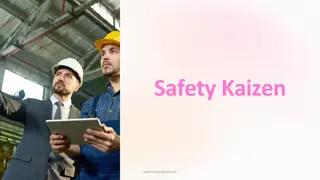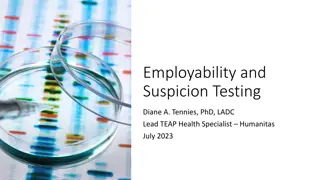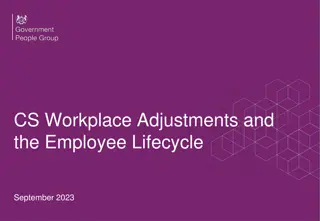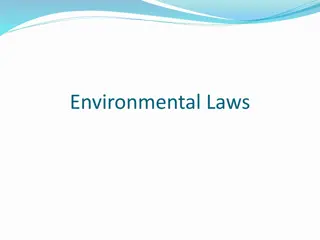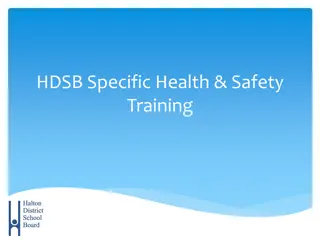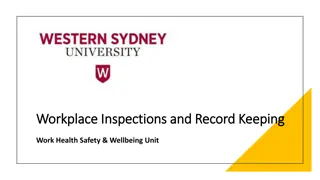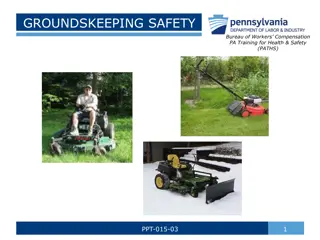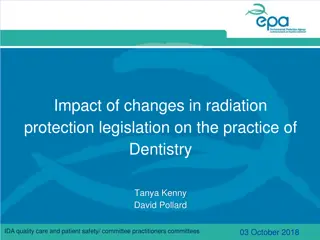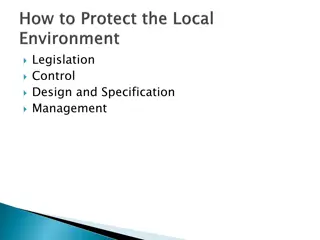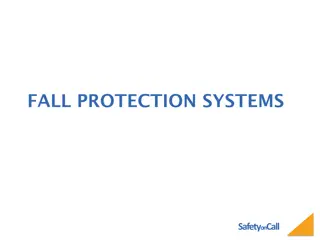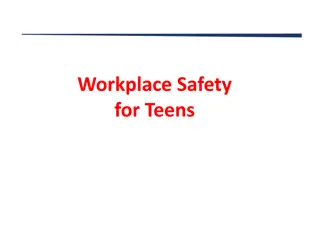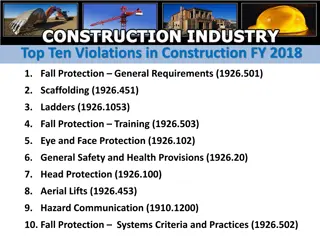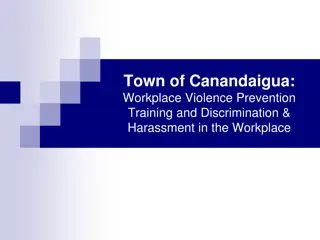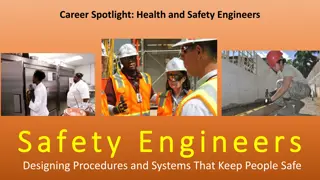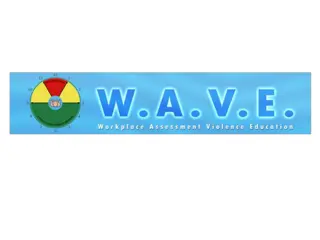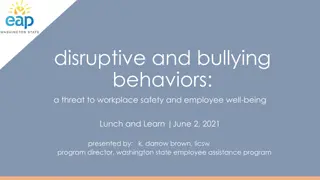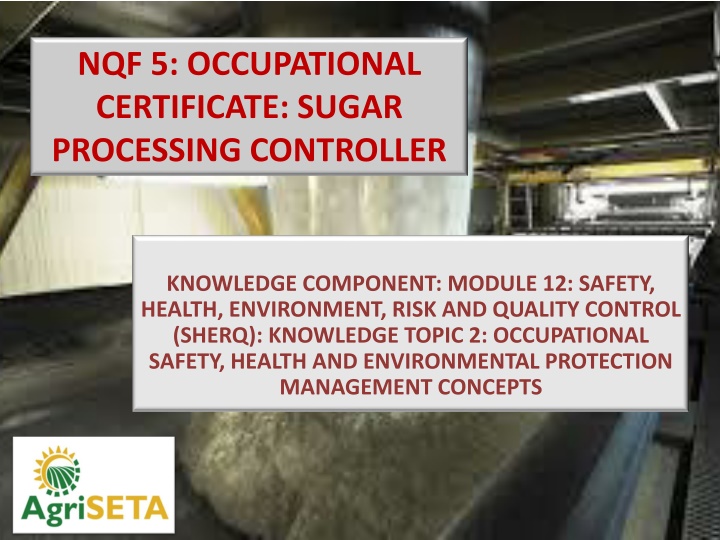
Legislation of Relevance in Workplace Safety and Environmental Protection
This content delves into key legislation such as the Occupational Health and Safety Act and the National Environmental Management Act, outlining their significance in ensuring worker safety, environmental protection, and sustainable development. It highlights the aims and provisions of these acts in promoting occupational health, safety, and environmental well-being.
Download Presentation

Please find below an Image/Link to download the presentation.
The content on the website is provided AS IS for your information and personal use only. It may not be sold, licensed, or shared on other websites without obtaining consent from the author. If you encounter any issues during the download, it is possible that the publisher has removed the file from their server.
You are allowed to download the files provided on this website for personal or commercial use, subject to the condition that they are used lawfully. All files are the property of their respective owners.
The content on the website is provided AS IS for your information and personal use only. It may not be sold, licensed, or shared on other websites without obtaining consent from the author.
E N D
Presentation Transcript
NQF 5: OCCUPATIONAL CERTIFICATE: SUGAR PROCESSING CONTROLLER KNOWLEDGE COMPONENT: MODULE 12: SAFETY, HEALTH, ENVIRONMENT, RISK AND QUALITY CONTROL (SHERQ): KNOWLEDGE TOPIC 2: OCCUPATIONAL SAFETY, HEALTH AND ENVIRONMENTAL PROTECTION MANAGEMENT CONCEPTS
Legislation of Relevance OCCUPATIONAL HEALTH AND SAFETY ACT Regulates workplace safety, health and environmental protection including appointments, compliance audits, repercussion and personal liability. The purpose of this Act is to: Provide for the health and safety of persons at work For the health and safety of persons in connection with the use of plant and machinery The protection of persons other than persons at work against hazards to health and safety arising out of or in connection with the activities of persons at work To establish an advisory council for occupational health and safety To provide for matters connected therewith.
Legislation of Relevance (cont.) OCCUPATIONAL HEALTH AND SAFETY ACT (cont.) The Occupational Health and Safety Act aims to make sure, as far as possible, that: Every worker has a safe working environment; Reduce incidents and accidents; Protect the environment for workers and their communities; Produce effective communication between workers, employers and communities.
Legislation of Relevance (cont.) THE NATIONAL ENVIRONMENTAL MANAGEMENT ACT To provide for co-operative environmental governance by establishing principles for decision- making on matters affecting the environment, Institutions that will promote co-operative governance and procedures for coordinating environmental functions exercised by organs of state; and To provide for matters connected therewith.
Legislation of Relevance (cont.) The National Environmental Management Act (cont.): The National Environmental Management Act aims to ensure that: Everyone has the right to an environment that is not harmful to his or her health or wellbeing The State must respect, protect, promote and fulfil the social, economic and environmental rights of everyone and strive to meet the basic needs of previously disadvantaged communities Sustainable development must be ensured for future generations Everyone has the right to have the environment protected, for the benefit of present and future generations, through reasonable legislative and other measures Pollution and ecological degradation is prevented Conservation is promoted.
Legislation of Relevance (cont.) COMPENSATION FOR OCCUPATIONAL INJURIES AND DISEASES ACT The governing Act that deals with occupational injuries and diseases. The aim of the COIDA is to provide for Compensation in the case of disablement caused by occupational injuries or diseases, sustained or contracted by employees in the course of their employment, or death resulting from such injuries or disease; and to provide for matters connected therewith. The COIDA basically prevents employees covered by the Act from suing their employers for damages in terms of common law.
Legislation of Relevance (cont.) An injury reduction incentive scheme put in place by a sugar mill
Legislation of Relevance (cont.) COMPENSATION FOR OCCUPATIONAL INJURIES AND DISEASES ACT (cont.) Anyone who employs one or more workers must register with the Compensation Fund and pay annual assessment fees. Claims for employees employed in the mining and building industries must be referred to the relevant mutual associations. Claims by employees working for individually liable employers (the state, parliament, the provincial authorities and local authorities which have been exempted from making payments to the compensation fund) must be referred to the employer.
Incident Investigation Investigation of workplace accidents and incidents is an essential part of the proactive management of health and safety. Undertaking investigations of both those accidents that result in injury or death, as well as near misses, in a systematic and organised way will benefit any organisation. Analysis of and accurate information about previous accidents and near misses helps to prevent them recurring. Health and Safety Executive inspectors (or local authority Environmental Health Officers, depending on jurisdiction) may also carry out an investigation of an accident within their enforcement powers. This topic discusses what should be investigated and how an investigation should be carried out, and by whom. It also delves into causation and the necessary training required to ensure those investigating are competent to do so.
Accident Reports The uses of accident reports: To determine the loss control rating, as a part of supervisors annual performance review For inspection by government and insurance officials, and by courts For evaluation in cases of liability For follow-up and corrective action
Accident Reports (cont.) Essential information and details for reports and forms: Where it happened Exact location of the incident When it happened Date and time of occurrence Date when the incident was reported How it happened
Accident Reports (cont.) The following must be carefully documented in the reporting system: Identify relevant information of the event Establish what has happened Identify the causes Establish the probability of recurrence Determine practical preventive measure based on the above Review and follow-up
Accident Reports (cont.) Employer s Obligations: An employer, in respect of each workplace where employees are performing work in his service, must designate in writing for a period determined by him, one or more full-time employees who are acquainted with conditions at the workplace, as a safety representative for that workplace or for different sections. The employer has a duty to ensure that the safety representative performs his assigned duties and must release the employee from normal duties for the purpose of carrying out the inspection. The employer must ensure that the safety representative reports to him after each inspection and must keep a record, signed by the safety representative. An employer shall in respect of each workplace where two or more safety representatives have been designated establish one or more safety committees which the employer must ensure shall hold meetings at least once in every three months, making available to the committee the current inspection records.
Accident Reports (cont.) Employer s Obligations: The employer must also ensure that the safety committee performs its statutory functions this entails making a suitable meeting place available, releasing committee members to attend the meeting. The employer has to write in the minutes whether any steps had been taken to implement any recommendations made by the safety representative and ensure that the minutes endorsed by him are kept, An employer is obliged to make an evaluation of the risk attached to any workplace condition or situation and take steps to reduce the risk. An employer is required to take reasonable steps to investigate the circumstances of every accident that is reported.
Accident Reports (cont.) Employee s Obligations: An employee is under a duty to report within 3 days to his/her immediate supervisor any incident in the workplace involving the injury of an employee consequent upon hazardous working conditions or heat stroke or exhaustion or an accident or exposure to a hazardous article. The site of the accident should not be disturbed before the arrival of an inspector. Employees have a duty to co-operate with employers to enable them to fulfil their statutory duties under the Health and Safety legislation related to the workplace. This would include reporting: dangerous occurrences near misses and accidents whether or not they resulted in injury, damage or disease. Employees are also required to co-operate in an investigation.
Requirements for Investigations As a very basic guide, an incident investigation should follow these four steps: Gathering information. Analysing information. Identifying risk control measures. Producing and implementing an action plan. Three levels of accident causation are identified through this procedure. Immediate causes. Underlying causes. Root causes.
Reasons for Investigations A better understanding of risk and provision of information for use in risk assessment Prevention of accidents and incidents in the future A powerful vehicle for motivating organisational learning and activating cultural change A means of understanding and obtaining information on management systems A useful means of demonstrating the status of safety management in an organisation which in turn can be used to assist in litigation claims and developing arguments for lowering insurance premiums Providing evidence of any discrepancy between what should be in place, eg safe systems of work, and what is actually
Risk Management Risk Management forms an integral part of manufacturing enterprises management system. Through this process risks that can impact on the efficiency, safety and profitability of a company can be identified prior to an occurrence. Mitigating measures that can assist to prevent the occurrence or to manage the effects of an occurrence can be put in place before any incident actually occurs. A risk management policy (and its related procedures) should be put in place: Now, if you have not done it before When a change occurs (for example changing work procedures) After an incident or near miss occurs At regularly scheduled times appropriate to the level of risk at your workplace. Sugar mill operators and cane rail operators should consult with affected persons, including external duty holders where necessary, when conducting risk assessments in areas of joint responsibility.
Risk Registers A risk register or list for all hazards at a workplace should be developed. Hazards can be classified under any one or more of the following areas: Biological hazards Energy and electricity Hazardous manual tasks Plant and equipment hazards Hazardous chemicals Work environment (Noise, inhalation, etc.).
Risk Management Process Operations Managers should consult workers and workplace health and safety representatives routinely at all stages to manage risk and to assist in the development of risk management procedures, including when: New work processes/equipment/tools are being designed, purchased or modified (consult early to allow changes to be incorporated) Identifying problem jobs which require assessment Establishing priorities for the assessment of problem jobs and during the risk assessment process Deciding on control strategies to reduce exposure to risk factors Reviewing the effectiveness of implemented control measures and identifying whether further risks of injury have been created by the chosen controls The contents of procedural documents are being decided, as experienced workers can help make sure they are as relevant as possible to the actual work situation.

